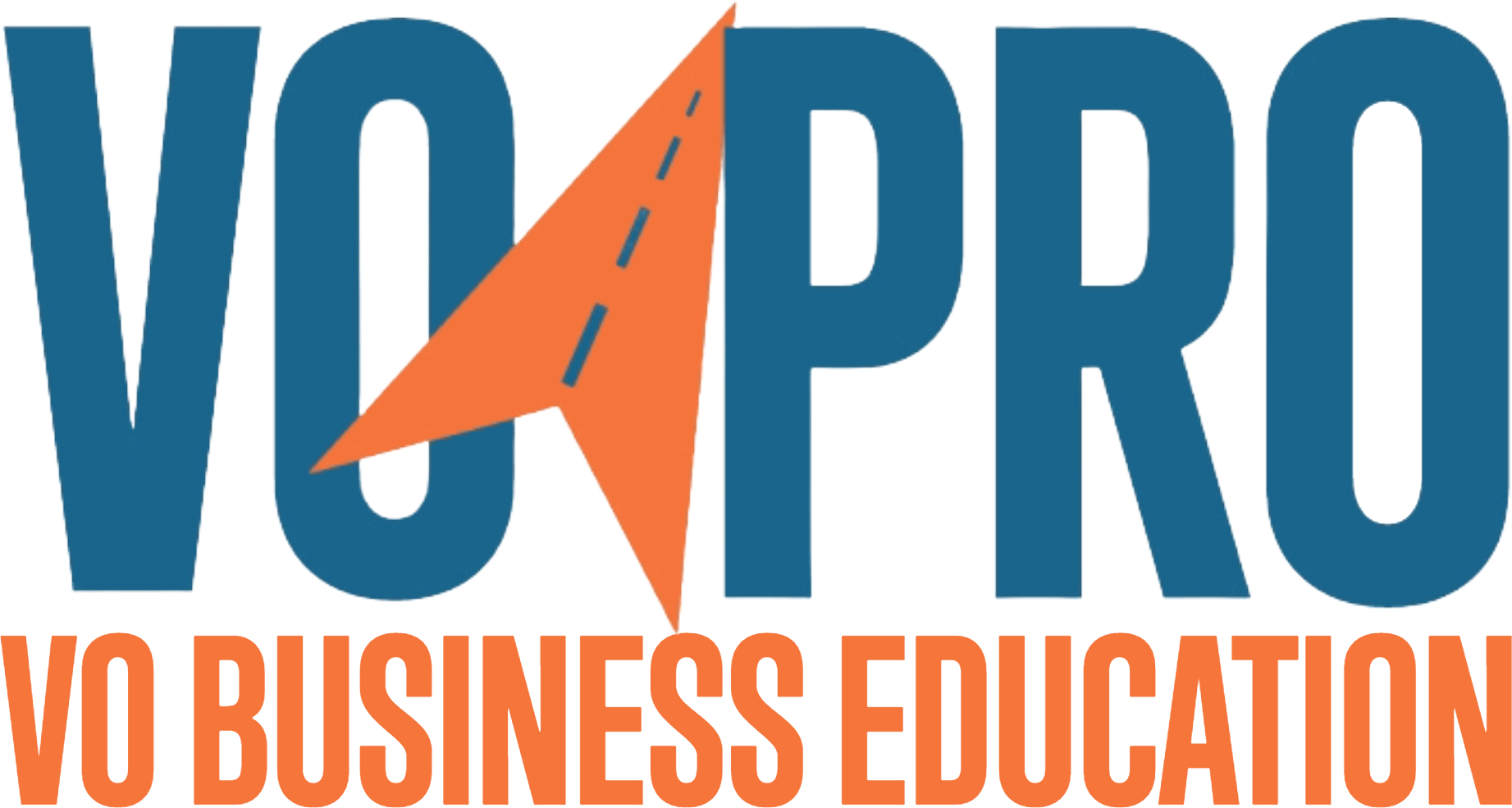The 6 Steps You're Missing and Why it's KILLING Your VO Business
Finding voiceover clients doesn’t have to feel like throwing spaghetti at a bunch of walls and praying it sticks. I call that spaghetti marketing.
And yet… that’s exactly what most beginner voice actors are doing. Scrolling pay-to-plays. Begging agents. Mass emailing casting directors who don’t keep a roster or work directly with talent.
If your VO career feels more like a guessing game than a business, this post is for you.
Because yeah, finding voiceover clients can be simple, strategic, and actually repeatable — if you stop chasing tactics and start building systems.
This isn’t about working harder. It’s about working smarter.
THE BIG MYTH: “If I’m good enough, clients will find me.”
Nope. They will absolutely not. At least not unless you’ve been practicing SEO for years.
And it’s not because you’re not talented. But because your ideal clients don’t spend their afternoons trolling Pay-to-Play sites hoping to discover new talent.
They’re busy making content. They’re under deadlines. Juggling budgets. Trying to get a project approved without a million rounds of revisions.
And unless your name magically pops into their inbox at the exact moment they need a voice (and the odds of that are astronomical), they’re not thinking about you.
That’s not a YOU problem. That’s a visibility problem.
Here’s the mindset shift:
You don’t need to be discovered. You need to be found — by the right people, in the right places, with the right message.
And that means learning how to market your VO business like a business.
Step 1: Know Who You’re Talking To (And Stop Talking to Everyone)
Trying to market to “anyone who needs a voice” is like opening a coffee shop that sells every kind of beverage — kombucha, boba tea, whiskey, protein shakes, lukewarm tap water — and hoping someone walks in.
You need focus.
Different clients care about different things. A museum director commissioning an audio tour doesn’t have the same needs as a freelance video producer editing a regional broadcast ad for Tri-State Area Volvo Dealers.
So let’s get specific.
Ask yourself:
• Who’s already hiring voice actors like me?
• What kind of content are they producing?
• Where do they spend time online?
• What problems do they have that I solve?
If you’re new, start small. Pick 1–2 genres you enjoy (and have a demo for) and build client avatars around them. Not sure how? Start with this: The Big Book of VO Client Avatars.
Step 2: Build a List — Yes, Even if You’re New
Let’s kill another myth: “I don’t have enough experience to reach out.”
Again. Nope.
You don’t need experience to introduce yourself. You need relevance.
And relevance comes from aligning your skills with their needs. That means you can absolutely reach out to video producers, creative directors, or marketing managers — if your message is positioned around how you help them, not your resumé.
Use tools like:
• Apollo.io or LinkedIn to find decision-makers.
• Hunter.io to verify email addresses.
• A basic CRM like HubSpot Sales (free) to track outreach.
Start with 50 leads in your target genre. Keep it lean. Quality > quantity.
This is one of the most effective ways to find voiceover clients without burning out.
Step 3: Write Emails That Sound Like a Pro (Not a Desperate Freelancer)
Most cold emails get deleted because they scream: “Hire me! Pick me! I need work!”
And nothing kills trust and confidence faster than desperation. Prospects smell it.
Instead, flip the script.
Your goal isn’t to book a job with one email. It’s to start a relationship.
Here’s a simple structure:
• Subject Line: Something short, relevant, and curiosity-driven (e.g. “Quick question about your next project”)
• Opening Line: Make it about them. Reference a project or niche.
• Middle: Address their pain points and challenges and how you help solve them.
• Call to Action: Something like, “If you keep a roster and are open to fresh talent, I’d love to be considered. You can preview or download my demos here: [Insert your website link].”
Keep it short. Keep it real. And follow up — respectfully.
Need help writing these? Try ClientConnect™ GPT, our AI email outreach copywriting assistant trained on proven outreach copy from thousands of successful VO marketing campaigns.
Step 4: Create a Client-Facing Website (Not Just a Pretty Portfolio)
Your website should not be a shrine to your gear, your studio, or how you “fell in love with VO as a kid doing silly voices.”
No one cares.
Here’s what clients do care about:
• What you sound like
• How easy you are to work with
• If you’re a fit for their brand or project
So give them that. Your homepage should answer these 3 questions fast:
1. What do you do? (Genre-focused tagline)
2. Who do you do it for? (Speak to your niche)
3. How can they hear you? (Demos above the fold — always)
Then, guide them to action: “Book me,” “Get a quote,” “Let’s talk.”
Want to level this up? Grab our free Voice Actor Website Strategy Guide for 10 conversion-focused strategies.
Step 5: Follow Up Like a Pro Without Being a Pest
This is where most voice actors blow it.
They send one email. Don’t hear back. And disappear like a bad Tinder date.
But the gold is in the follow-up. Not obnoxiously. Not every month. But with tact, timing, and value.
Use a system. Build sequences.
After you’ve introduced yourself and pointed out your demos, the goal is to stay top of mind over time. How? Not by begging for work. Not by “checking in” or “touching base,” or “I hope this email finds you well.”
You need to provide value to the prospect with every single touch. What does that mean? It means understanding in granular detail their role, their challenges, their pain points and being able to offer something of value that may alleviate that pain (and here’s the kicker) whether it has to do with you and your solutions or not.
In fact, preferably not.
You need to build awareness, yes, but more importantly, you need to build trust and consultative value. Over time,
Remember: you’re building familiarity and staying top of mind, not closing a deal in one shot.
Step 6: Make It a System, Not a Sprint
This is the difference between “I’m trying to find voiceover clients” and “I have a marketing engine that brings in clients consistently.”
If you’re hustling new outreach every day without a repeatable structure, you’re on the fast track to burnout.
Instead:
• Set a weekly outreach goal (ex: 25 personalized emails)
• Block time for research, writing, follow-ups
• Use a CRM to track your client outreach
• Review your numbers once a month: open rates, replies, roster adds, auditions, booked jobs.
Marketing takes data, discipline, and patience.
You won’t hear back from everyone. You will get ignored the overwhelming majority of the time. And occasionally, you’ll get that reply that turns into a dream client.
Don’t chase dopamine hits. Build consistency.
Bonus: What Not to Do
Let’s talk about a few common mistakes beginners make when trying to find voiceover clients:
• ❌ Relying solely on casting sites (you’re renting opportunities, not building a business)
• ❌ Posting to Instagram and calling it marketing (that’s content, not outreach)
• ❌ Messaging people out of the blue without research or relevance (spammy and ineffective)
• ❌ Waiting for work to come to you (that’s not a strategy — that’s hope and it doesn’t work)
If you’re stuck in any of these patterns, it’s time to pivot. You’re not bad at marketing — you’ve just been sold the wrong playbook.
The Real Secret to Booking Clients Consistently
Clients don’t hire you because you’re the best voice actor in the world.
They hire you because you:
• Show up when they need you, early, or at least on time
• Make their job easier, smoother, and more fun.
• Sound great doing it
Your job is to make hiring you a no-brainer. That means being easy to find, pleasant to deal with, and consistently present in their world.
That’s it.
No gimmicks. No begging. Just smart marketing and simple systems.
Ready to Get Serious?
If you’re tired of crossing your fingers and hoping a casting notice magically fits your voice…
If you’re over feeling like a passive passenger in your VO career…
Then it’s time to take the wheel. Start building your outreach system.
Download The Big Book of VO Client Avatars. Use it to identify your target clients. Then use the VO ClientConnect™ GPT to write your first email drafts.
Give it one month of consistent, focused outreach — and you’ll be miles ahead of most voice actors.
Finding voiceover clients doesn’t require blowing money and time on the pay-to-plays, a fancy agent, or being “lucky.”
It requires a clear offer, a clear target, and consistent communication. That’s it.
You don’t need more talent. You need more traction. And that starts today.


